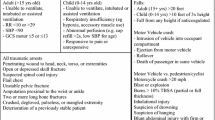Abstract
Objective
To determine the cost-effectiveness of trauma room CT compared with CT performed at the radiology department.
Methods
In this randomised controlled trial, adult patients requiring evaluation in a level 1 trauma centre were included. In the intervention hospital the CT system was located within the trauma room and in the control hospital within the radiology department. Direct and indirect medical costs of the institutionalised stay and diagnostic and therapeutic procedures were calculated.
Results
A total of 1,124 patients were randomised with comparable demographic characteristics. Mean number of non-institutionalised days alive was 322.5 in the intervention group (95 % CI 314–331) and 320.7 in the control group (95 % CI 312.1–329.2). Mean costs of diagnostic and therapeutic procedures per hospital inpatient day were €554 for the intervention group and €468 for the control group. Total mean costs in the intervention group were €16,002 (95 % CI 13,075–18,929) and €16,635 (95 % CI 13,528–19,743) for the control group (P = 0.77).
Conclusion
The present study showed that in trauma patients the setting with a CT system located in the trauma room did not provide any advantages or disadvantages from a health economics perspective over a CT system located in the radiology department.
Key Points
• Computed tomography has become increasingly important in patients who have suffered trauma.
• Emergency departments either use embedded CT facilities or CT machines in the radiology department.
• The cost-effectiveness of CT was not influenced by the location of CT.
• The number of non-institutionalised days alive was not influenced by the location.
• Further assessment of optimal location of CT units is required.


Similar content being viewed by others
References
Waydhas C (1999) Intrahospital transport of critically ill patients. Crit Care 3:R83–R89
Fung Kon Jin PH, Goslings JC, Ponsen KJ, van KC, Hoogerwerf N, Luitse JS (2008) Assessment of a new trauma workflow concept implementing a sliding CT scanner in the trauma room: the effect on workup times. J Trauma 64:1320–1326
Saltzherr TP, Bakker FC, Beenen LFM, Dijkgraaf MGW, Reitsma JB, Goslings JC (2012) Randomized clinical trial comparing the effect of computed tomography in the trauma room versus the radiology department on injury outcomes. Br J Surg 99(S1):105–113
Champion HR, Sacco WJ, Copes WS, Gann DS, Gennarelli TA, Flanagan ME (1989) A revision of the Trauma Score. J Trauma 29:623–629
Oostenbrink JB, Koopmanschap MA, Rutten FF (2002) Standardisation of costs: the Dutch manual for costing in economic evaluations. Pharmacoeconomics 20:443–454
Oostenbrink JB, Buijs-Van der Woude T, van Agthoven M, Koopmanschap MA, Rutten FF (2003) Unit costs of inpatient hospital days. Pharmacoeconomics 21:263–271
Centraal Bureau voor de Statistiek (CBS) (2009). www.cbs.nl. Accessed 23 Jan 2010
Fung Kon Jin PH, Dijkgraaf MG, Alons CL, van Kuijk C, Beenen LF, Koole GM, Gosling JC (2011) Improving CT scan capabilities with a new trauma workflow concept: simulation of hospital logistics using different CT scanner scenarios. Eur J Radiol 80:504–509
Acknowledgments
This trial was funded by an unrestricted grant from ZonMw, the Netherlands organization for health research and development (grant number 3920.0005). We would like to thank the REACT trial Advisory Committee for their input and efforts during the design, preparation and conduction of the trial. The authors kindly thank M.G.T. Beentjes, G.F. Giannakopoulos, J. Mouthaan, M. Scholing and K.J. Vos for their efforts and advice in relation to data collection. We thank all prehospital personnel and trauma care organizations for their cooperation and efforts in enabling the conduction of this study.
Author information
Authors and Affiliations
Consortia
Corresponding author
Additional information
Members of the REACT study group are P.M.M. Bossuyt, P.H.P. Fung Kon Jin, C.P. Henny, G. Koole, J.S.K. Luitse and K.J. Ponsen.
Rights and permissions
About this article
Cite this article
Saltzherr, T.P., Goslings, J.C., Bakker, F.C. et al. Cost-effectiveness of trauma CT in the trauma room versus the radiology department: the REACT trial. Eur Radiol 23, 148–155 (2013). https://doi.org/10.1007/s00330-012-2593-0
Received:
Revised:
Accepted:
Published:
Issue Date:
DOI: https://doi.org/10.1007/s00330-012-2593-0




